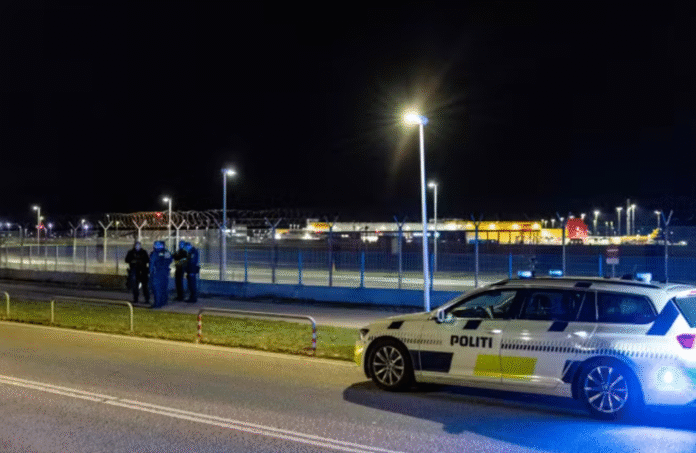Drone Attacks Denmark: A Vulnerability Exposed
The recent drone attacks Denmark has witnessed across airports, military bases, and energy facilities have sparked national and international concern. While no physical harm or damage has been reported, the incidents revealed troubling vulnerabilities in Denmark’s defense systems, vulnerabilities that have left the country embarrassed and searching for effective countermeasures.
Denmark, a founding member of NATO, is now under pressure to act decisively in the face of what experts are calling hybrid warfare.

How Drone Attacks Denmark Unfolded
The string of drone attacks Denmark began with sightings at Aalborg and Billund airports, both forced to shut down temporarily. Drones were also spotted over Esbjerg, Sønderborg, and Skrydstrup, the latter housing advanced F-35 and F-16 fighter jets.
Military bases weren’t the only targets. Reports emerged of drones flying near oil and gas platforms in the North Sea and around Korsør port, raising concerns about the safety of critical infrastructure.
The Danish police confirmed Aalborg airport was briefly closed again the following night due to another suspected drone sighting.
NATO and Hybrid Warfare
Experts warn that these drone attacks Denmark experienced are part of a wider trend. NATO members along the eastern flank, including Poland, Estonia, and Norway, have all been subjected to similar tactics in recent weeks.
-
Estonia and Poland invoked NATO’s Article 4, which calls for urgent consultations when a member’s security is threatened.
-
Polish authorities even shot down around 20 Russian drones violating their airspace.
While Denmark has not yet invoked Article 4, Defence Minister Troels Lund Poulsen called the attacks “systematic” and classified them as a hybrid attack.
Who Is Behind the Drone Attacks Denmark?
The Danish government has suggested that a “professional actor” is behind the incidents but has avoided naming a culprit. Still, suspicion looms heavily over Russia.
Prime Minister Mette Frederiksen recently declared that Russia “will be a threat to Europe and Denmark for years to come,” though Moscow strongly denies involvement. The Russian embassy in Copenhagen dismissed the events as a “staged provocation.”
This uncertainty leaves Denmark in a difficult position: without hard evidence, pointing fingers risks escalating tensions, but doing nothing may embolden further attacks.
Why Denmark Hasn’t Shot Down Drones
One of the most pressing questions is why Denmark’s military hasn’t intercepted the drones. Defence Chief Michael Hyldgaard explained:
“When you shoot something down in the air, something also comes down again.”
In other words, downing drones over urban areas or airports could create collateral damage from falling debris, fuel, or batteries. Analysts agree that caution is wise but stress this is not a sustainable long-term strategy.
Expert Opinions on the Drone Attacks Denmark
Kjeld Jensen, from the University of Southern Denmark’s drone center, admitted that the incidents are embarrassing but defended the authorities’ restraint:
-
Shooting drones over populated areas risks fire and destruction.
-
Letting drones fly unchecked, however, exposes national weaknesses.
Peter Viggo Jakobsen of the Royal Danish Defence College emphasized that Denmark must “come up with ideas” to counter the threat, as simply allowing drones to roam free is untenable.
Denmark vs. Poland: Two Different Approaches
Poland has adopted a far more aggressive response than Denmark. After Russia’s incursions into its airspace, Polish Foreign Minister Radek Sikorski warned at the UN:
“If another missile or plane crosses our territory without permission … do not come here to complain. You have been warned.”
This stark contrast highlights Denmark’s cautious stance, which many argue makes it appear vulnerable in the eyes of adversaries.

Possible Solutions to Drone Attacks Denmark
Denmark is exploring new defense measures, including an integrated layered air defense system and investment in long-range precision weapons. Yet, experts admit these measures are years away from deployment.
The European Union has also proposed a “drone wall”, an early detection and defense system along the EU’s eastern borders. Denmark will join NATO allies and Ukraine to discuss this plan. However, analysts warn that simple, low-cost drones may still slip through.
The Larger Geopolitical Impact
If Russia is indeed responsible for the drone attacks Denmark has faced, then the operation can be deemed a success under hybrid warfare tactics. Without firing a single shot, the drones managed to:
-
Temporarily close airports.
-
Expose vulnerabilities in military and civilian infrastructure.
-
Force senior government officials to hold emergency press conferences.
-
Shake public confidence in Denmark’s defense capabilities.
This outcome shows how modern conflicts can undermine nations without conventional weapons or open warfare.
Denmark’s Next Move
For Denmark, the immediate challenge is to reassure its citizens and allies that it can protect its airspace and infrastructure. Police have raised the crisis level, while the defense minister warned that the nation faces “a new reality.”
Whether through technological upgrades, NATO cooperation, or invoking Article 4, Denmark must now decide how to respond to the ongoing threat.
Conclusion: Lessons From the Drone Attacks Denmark
The drone attacks Denmark has endured are a wake-up call, not just for Copenhagen but for the entire NATO alliance. In today’s world, small, low-cost drones can disrupt nations, spark panic, and reveal weaknesses in even the strongest militaries.
For Denmark, this crisis is both an embarrassment and an opportunity, a chance to modernize its defenses and prove that NATO allies can adapt to the new age of hybrid warfare. The coming months will show whether Denmark chooses caution or decisive action.

